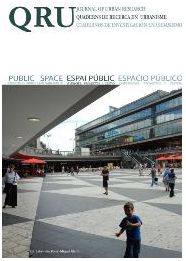Los espacios híbridos en Hong Kong
DOI:
https://doi.org/10.5821/qru.9542Resum
En las últimas décadas la ciudad de Hong Kong se ha consolidado como un importante centro financiero y de producción, aspirando a convertirse en una de las ciudades globales del nuevo milenio. Hong Kong representa un caso ejemplar donde la permeabilidad de la estructura urbana permite recorrer la ciudad de una manera intensiva, disfrutando diferentes niveles de utilización y donde los edificios constituyen parte de la complejidad de los flujos que diariamente la atraviesan. Esta complejidad, lleva a la creación de espacios híbridos, o sea aquellos que no son ni propiamente públicos ni privados y que representan un aspecto distintivo de la conformación de la ciudad. En Hong Kong los límites entre espacio público y privado suelen desvanecer. La falta de límites, no se refiere necesariamente a la diferencia entre espacios abiertos y cubiertos, sino espacios públicos que se encuentran dentro de las propiedades privadas, áreas grises donde es difícil entender que tipología de espacios atravesamos. En muchos distritos de la ciudad, la mayoría de los espacios se utilizan para fines comerciales, dejando en segundo plano la función propia del espacio público, que de elemento estructurante ha pasado a ser residual o, incluso, a desaparecer por la pérdida de su rol o por la sustitución por otros espacios más funcionales para los requerimientos económicos actuales.Descàrregues
Número
Secció
Llicència
Aquellos autores/as que tengan publicaciones con esta revista, aceptan los términos siguientes:
Los autores/as conservarán sus derechos de autor y garantizarán a la revista el derecho de primera publicación de su obra, el cuál estará simultáneamente sujeto a la Licencia de reconocimiento de Creative Commons CC BY-NC-ND- 4.0 que permite a terceros compartir la obra siempre que se indique su autor y su primera publicación esta revista, pero no se pueden cambiar ni se pueden utilizar comercialmente.
Los autores/as podrán adoptar otros acuerdos de licencia no exclusiva de distribución de la versión de la obra publicada (p. ej.: depositarla en un archivo telemático institucional o publicarla en un volumen monográfico) siempre que se indique la publicación inicial en esta revista.
Se permite y recomienda a los autores/as difundir su obra a través de Internet (p. ej.: en archivos telemáticos institucionales o en su página web) antes y durante el proceso de envío, lo cual puede producir intercambios interesantes y aumentar las citas de la obra publicada. (Véase El efecto del acceso abierto).













